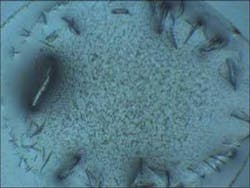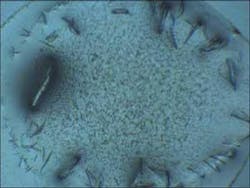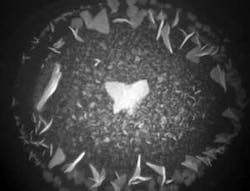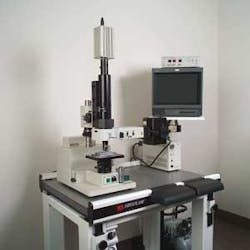In the late 1990s, Vu Tran, president of Korima (Carson, CA), and Gil Ravich, president of Ravich Research (Lawndale, CA), developed a microscope that could image samples under ultraviolet (UV) light. They developed this scope to “see” down to about 0.2 µm to examine semiconductors. When electronics makers started using nitrides, though, UV couldn’t go through them. That turned Tran and Ravich’s scope into a fossil. “I was very frustrated,” says Tran, “and I put the microscope in my garage and said, ‘Forget it!’”
Then, in the summer of 2003, Tran and Ravich’s luck changed. Someone from a pharmaceutical company–they won’t say which one–approached them about using their scope to image proteins. By adding two filters, the pair made their UV microscope focus on light at 280 nm, where crystalline proteins fluoresce and are thus distinguishable from salt crystals. Making this distinction is a key step in deciding whether to move a protein to x-ray crystallography to find its structure, which helps pharmaceutical scientists understand a disease target or refine a drug. Unfortunately, the pharmaceutical company and Korima couldn’t agree about ownership of intellectual property, so Tran and Ravich put away their scope once more.Ultraviolet vision
Although various nomenclatures define UV’s span differently, it is said to range from 10 or so nanometers to 400. “One advantage to using UV microscopy is that it allows you to image features that would not normally be seen with a standard visible-range microscope,” says Paul Martin, president of CRAIC Technologies (San Dimas, Calif.). The shorter wavelengths of UV reveal things that visible light cannot.
In many situations, though, scientists want an instrument that works over a range of wavelengths. Consequently, CRAIC developed the UVM-1 Ultraviolet Microscope, which works in UV, visible, and near-infrared (NIR) regions. “It was a real challenge to achieve high image quality while using the same optics over such a broad spectral region,” says Martin.
Given growing competition, however, no one reveals the precise details behind any optical device. As Martin says, it requires “experience, advanced optical design, and extensive experimentation.”
Some companies apply such experience to specific pieces, like the NanoVue 248 nm 4X Deep UV Zoom from Navitar (Rochester, NY). William Bridson, director of research and development at Navitar, says that this lens “is being used in a number of common biological applications where specimens are transparent in the visible region, but absorb light in the ultraviolet spectrum.” Beyond looking for protein crystals, says Bridson, this lens can be used for “pharmaceutical quality control, contaminant analysis, cellular imaging, and DNA analysis.”UV microscopy also requires the right illumination. While Rapp Optoelectronics (Hamburg, Germany) makes UV microscopes, it also makes light sources. “We use white light, and then filters and optics optimize the wavelength,” says Gert Rapp, general manager. If someone needs high-power light at, say, 220 nm, Rapp uses pulsed xenon light as the source. In short, though, different applications need different features. As an example, Rapp notes that “DNA absorbs strongly at around 260 nm, so you can measure it directly.”
Rapp Optoelectronics will even modify a customer’s existing microscope for UV applications. “We’ve done that on a variety of microscopes,” Rapp says.
Digging even deeper
To look even closer at samples, some scientists turn to x-rays. Conventional x-rays–because of their high energy–go right through a sample and get detected on a photographic plate. Soft x-rays, though, are lower in energy, and they get absorbed. “Soft x-rays use diffraction optics. You can make lens and mirrors and nanostructures with features about the size of the wavelengths,” explains David T. Attwood, professor in residence in electrical engineering and computer science at the University of California at Berkeley and director of the Center for X-Ray Optics at the Lawrence Berkeley National Laboratory.
These wavelengths for soft x-rays go down to about 20 nm, at the shortest range of what some scientists still call UV. “At 20 nm,” says Attwood, “all materials are absorptive there.” So soft x-rays provide natural contrast with biological materials. Compared with looking at protein crystals at 280 nm, a soft-x-ray system increases the resolution by a factor of more than 10.
Consequently, soft-x-ray microscopy can be used to image a variety of subcellular features. “In the cytoplasm,” says Attwood, “you would see the vesicles, and you can measure their variant absorption.”
Still, soft x-rays create some obstacles. For example, a sample must be fixed, so you can’t see dynamic events. Nonetheless, Attwood points out that soft-x-ray microscopy is faster than electron microscopy, while providing similar resolution. “You can look at lots of samples and do statistics,” he says. “You can also do so with three-dimensional imaging.” A researcher, for example, could look at the distribution of proteins and then knock out a gene and see if the distribution changes.
In the June 2008, Journal of Structural Biology, Dilworth Y. Parkinson of the Lawrence Berkeley National Laboratory and colleagues describe using soft x-rays to create three-dimensional images of schizosaccharomyces pombe–or yeast–cells. As Dilworth and colleagues write: “In addition to imaging intact cells, soft-x-ray tomography has the advantage of not requiring the use of any staining or fixation protocols–cells are simply transferred from their growth environment to a sample holder and immediately cryofixed. In this way the cells can be imaged in a near native state.
“Soft-x-ray tomography is also capable of imaging relatively large numbers of cells in a short period of time, and is therefore a technique that has the potential to produce information on organelle morphology from statistically significant numbers of cells.”
As with many advances in microscopy, UV and its near neighbors give scientists a closer look at biology. Moreover, researchers are only beginning to see what this technology can reveal.
About the Author
Mike May
Contributing Editor, BioOptics World
Mike May writes about instrumentation design and application for BioOptics World. He earned his Ph.D. in neurobiology and behavior from Cornell University and is a member of Sigma Xi: The Scientific Research Society. He has written two books and scores of articles in the field of biomedicine.



